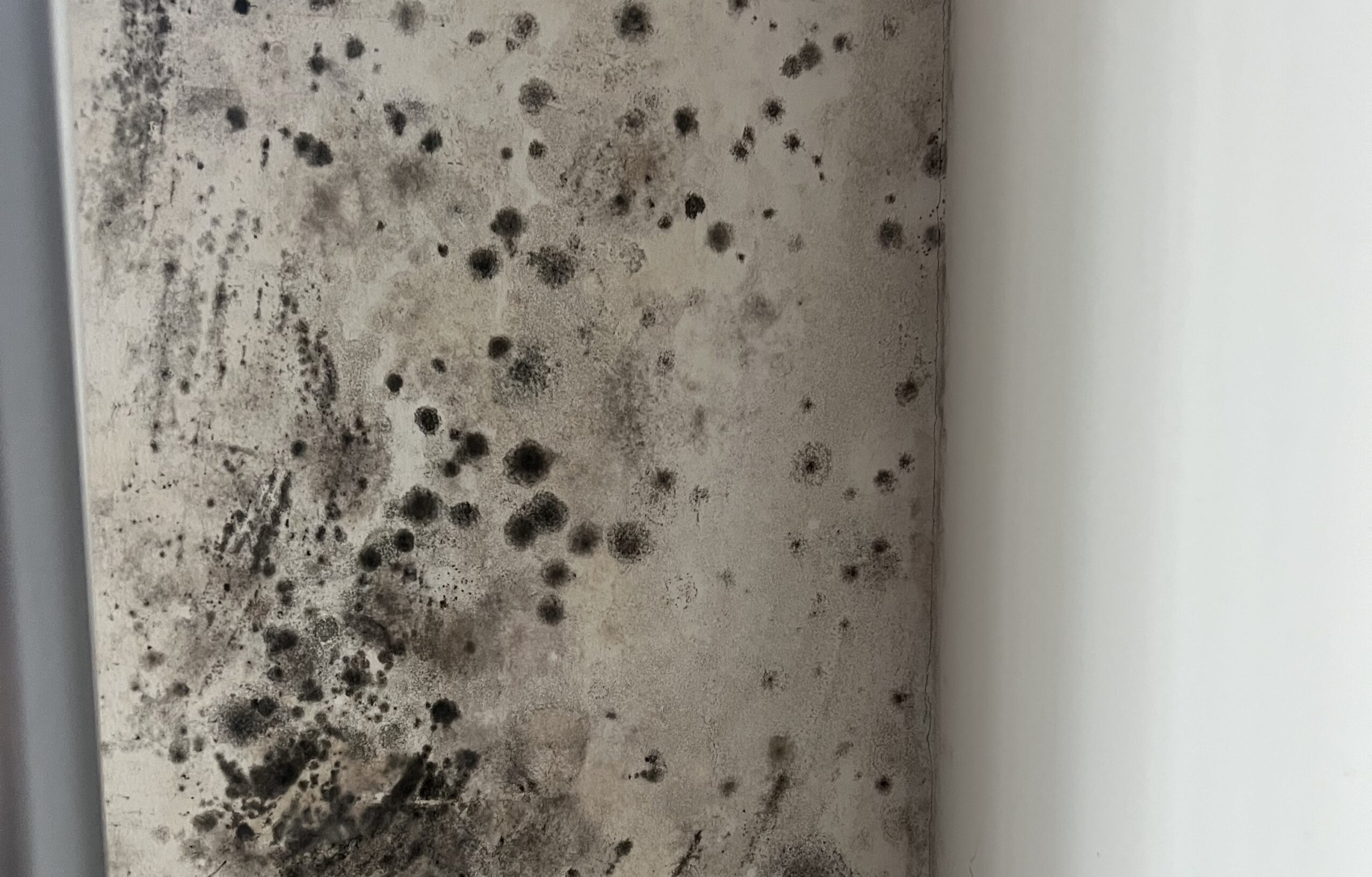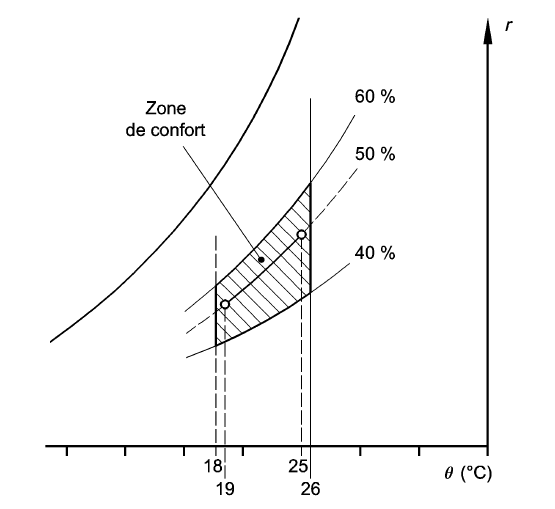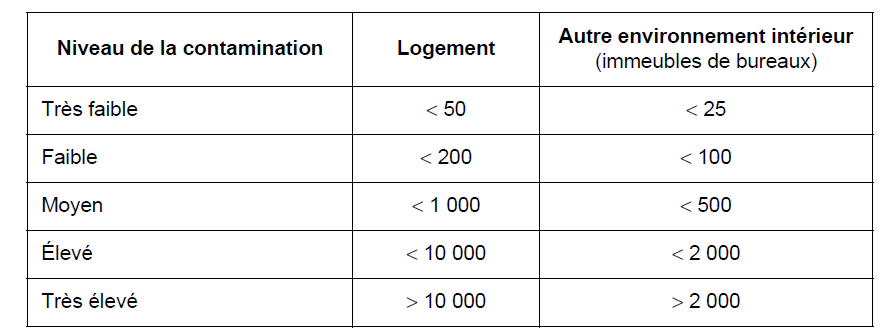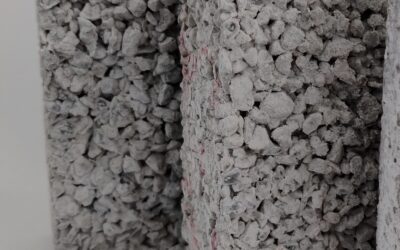Humidity, materials, and mold: a trio posing a risk to indoor air quality
Moisture promotes mold growth in buildings, damaging materials and indoor air quality. This can lead to allergies and respiratory problems. Sensitive materials such as wood and plaster are particularly vulnerable. Good ventilation and moisture monitoring are essential to prevent these risks.

Indoor air quality: a health issue
Indoor air quality has become a growing concern in our modern societies, where we spend on average more than 80% of our time in enclosed spaces—homes, offices, transportation, shops, or public buildings. This prolonged exposure makes indoor air quality essential to preserving our health. However, many buildings show visible or invisible signs of contamination, particularly from mold, which can appear as dark spots on walls, ceilings, or furniture.
Among the factors influencing this deterioration, humidity plays a central but often underestimated role. Whether it comes from leaks, condensation, or capillary action, humidity is one of the factors that promotes the growth of mold, which can damage materials and release harmful particles into the air.
This article aims to provide a better understanding of how humidity promotes mold growth, analyze the impacts on the health of occupants and on building materials, and propose concrete solutions to prevent these risks.
How does moisture appear in buildings?
The difference between relative and absolute humidity
According to the Larousse dictionary, humidity is the “water content of soil or the atmosphere.” But what is the difference between relative humidity and absolute humidity?
- Absolute humidity: this is the mass of water vapor contained in a given volume of air, generally expressed in grams per cubic meter (g/m³). It does not depend on temperature.
- Relative humidity: this is the ratio (in %) between the amount of water vapor present in the air and the maximum amount that the air can hold at a given temperature before becoming saturated (dew point). It depends heavily on temperature.

Representation of the comfort zone (temperature and humidity) based on standard NFP X 43-407
In simple terms, absolute humidity is the actual amount of water in the air, like measuring the number of invisible water droplets floating around us. Relative humidity, on the other hand, indicates how “full” the air is with water compared to its maximum capacity. For example, warm air can hold more water than cold air. So, if we have the same amount of water in warm air and cold air, the warm air will feel less humid because it could hold even more.
Where does moisture on walls or ceilings come from?
The source of moisture in the air or building materials is often linked to:
- water damage
- a leak in a clean water or wastewater pipe
- a defect in the roof
- cracks in a wall
This damage leads to water seeping into the smallest gaps and cracks in the materials. The water accumulates and soaks into the wall or ceiling. This significant amount of water promotes the germination of mold conidia and the degradation of materials.
Which parts of a building are at high risk of moisture damage?
There are many sources of moisture, and certain areas of a building are more vulnerable than others.
In homes, bathrooms and kitchens are at risk due to the presence of water supply and drainage pipes. Damage to these pipes (perforation, cracks) can very quickly cause large volumes of water to spread throughout a room or partition walls.
In office buildings, areas at risk include restrooms, but also ceilings and floors, which may contain water pipes, such as those carrying chilled water for air conditioning workspaces.
Which materials are most sensitive to moisture?
The sensitivity of materials to moisture is directly related to their water retention capacity.
Naturally, plaster-based materials, glass wool insulation, and bio-based insulation tend to retain water.
However, combinations of materials or treatments with specific molecules can reduce the water retention capacity of materials.
This is why, for example, there are types of plaster that can be used in damp rooms.
How does mold grow in a building?
The ideal conditions for mold growth on a wall or ceiling
To grow, mold needs nutrients and the right temperature and humidity. The two essential elements are:
- the presence of available water
- a source of organic carbon to eat
Mold can grow in a wide range of conditions, from a refrigerator at 4°C to a steam room at 40-45°C. In both cases, the environment is humid with relative humidity close to 100%, but the molds that will grow are not necessarily the same.
The most important factor in promoting mold growth is the presence of available water (Aw – Activity water).
Life cycle of molds
A mold spore (conidia) is carried through the air and settles on a surface.
If conditions are favorable, and water is available, it swells as it absorbs water and reactivates all the metabolites (machinery) that enable it to be active.
It then begins to build its first hypha, a kind of small filament that allows it to search for food (using its radar at the apex, or tip, of the hypha).
To feed, the fungus seeks out carbon-containing nutrients and can feed on the surface of materials, but also by penetrating them if they allow it to do so.
The growth of the mold will produce hyphae branches to form a thallus, then reproductive structures. The reproductive structures are aerial and produce conidia (spores), cells that can be compared to seeds. Conidia are easily detached from the mold by air currents such as wind and dispersed into the environment.
Once the conidia find suitable conditions for growth, the cycle begins again.
Materials prone to mold stains
Mold needs water to grow, but also a source of carbon that is easily assimilated.
Mold acts as a forest maintenance agent by breaking down dead trees and plants. Among other things, it has the ability to break down cellulose and other polymers.
As a result, mold easily grows on materials containing cellulose in buildings, such as:
- Wood
- Paper
- Plasterboard
- Upholstery containing natural fibers
- …
The impact on indoor air quality
The launch of spores and volatile organic compounds (VOCs)
During the mold life cycle, their reproductive organs produce spores (conidia). These are released into the environment through the air.
These emissions allow mold to colonize other spaces. Due to their light weight and aerodynamic shape, mold spores can be transported a few centimeters or several thousand kilometers (ambient air).
The release of spores leads to an increase in biological particles suspended in indoor air. This is referred to as a deterioration in the (microbiological) quality of indoor air. This deterioration can have an effect on the health of occupants.

Assessment of air contamination levels based on mold concentrations (CFU/m3) – source: Standard XP X 43-407
Molds do not only spread spores into the air. They also produce chemical molecules, known as Volatile Organic Compounds (VOCs), during their growth process. These chemical compounds sometimes have characteristic odors, such as geosmin, which gives off a smell of wet earth. These molecules can have an effect on human health, even though exposure thresholds are difficult to define.
The deterioration of air quality and its consequences on health
The presence of mold spores or chemical molecules produced by mold can have an impact on health.
Depending on their shape or the surface of their walls, mold spores can cause allergic reactions in sensitive individuals.
The effect can be exacerbated or increased by high concentrations in the air and prolonged exposure. Allergic reactions can occur on the skin upon contact with spores, but also in the lungs, causing disorders such as asthma.
VOCs and mycotoxins can produce the same effects, but to date there have been few scientific studies demonstrating all the effects on the human body.
Prevention and solutions
Humidity monitoring
In order to prevent the risks associated with high relative humidity in a building, monitoring temperatures and humidity levels is a simple first step.
In a home, this can be done using a small, simple weather station or a connected device.
For commercial and industrial buildings, museums, and archives, monitoring will be carried out using specific sensors that can issue alerts as soon as an exceedance is detected.
Ventilation, dehumidification, selection of materials
In order to prevent an increase in relative humidity in a building, which promotes the growth and spread of mold, it is important to limit its intake. First, it is recommended to choose materials that are resistant to mold growth and to carry out installation work in accordance with best practices and DTU standards.
Once the construction or renovation of the building meets the expected criteria, it is important to implement technical solutions to prevent moisture accumulation in interior spaces.
The first step is to ventilate the building properly:
- in residential buildings, ventilation should be of the single-flow or dual-flow CMV (Centralized Mechanical Ventilation) type
- in commercial, industrial, or public buildings, ventilation should be of the Air Handling Unit (AHU) type.
In cases where ventilation is insufficient or water damage has led to significant humidity in a building, dehumidification will be necessary.
There are several solutions for dehumidifying a building:
- If the problems encountered in the building are limited to relative humidity slightly higher than the recommended maximum of 60% and there has been no water damage, after checking the ventilation, the use of a mobile dehumidifier may be sufficient.
- If there has been water damage (broken pipes, capillary rise, roof leaks, etc.), it is strongly recommended that you call in a professional who has the equipment and expertise to carry out proper drying.
In all cases, it is very important to treat moisture problems as quickly as possible to prevent mold growth and deterioration of materials and air quality.
Antifungal treatments and good maintenance practices
Traces of mold are visible on a surface of your building or home.
If the total surface area affected by mold is less than 1m² across the entire building, it is possible for you to treat it yourself. The treatment must be carried out in accordance with certain rules. You must wear PPE (Personal Protective Equipment): gloves, FFP2 or FFP3 mask, goggles. To treat the mold properly, you must use a cleaning product that has been approved as antiseptic and suitable for mold. Cleaning and treatment should be carried out using a disposable cloth or paper soaked in the cleaning product over the entire contaminated area. Once the area has been cleaned and after the drying time recommended by the product manufacturer, a second pass should be made again with new cloths moistened with the disinfectant.
If the mold-contaminated surface is larger than 1m², it is recommended that you call in a decontamination specialist: they will be able to suggest a suitable disinfection protocol to eradicate the mold and provide advice on how to prevent it from reappearing.
Conclusion
Excessive humidity in buildings is much more than just a nuisance: it is a trigger for mold growth, with direct consequences for materials, air quality, and the health of occupants.
Understanding the mechanisms of fungal growth, identifying areas at risk, monitoring humidity levels, and adopting appropriate technical solutions are all ways to prevent these problems.
It is essential to have your building inspected, to take simple measures such as ensuring good ventilation, and to consult professionals in the event of contamination.
For more information, feel free to explore our additional resources or contact our team for personalized support.
FAQ – Air, Moisture, and Materials
Why is indoor air quality important for building materials?
Poor air quality (pollutants, excessive humidity) can accelerate the deterioration of materials such as wood, plaster, or paint.
How does humidity affect the performance of materials?
Moisture can cause mold, swelling, cracks, or loss of thermal insulation.
Which materials are most sensitive to moisture?
Materials that contain cellulose, such as wood, plasterboard with facing, organic insulation, and that do not have specific antifungal protection.
How can I measure humidity in the ambient air?
Using a hygrometer, which indicates relative humidity as a percentage (% RH).
What is the ideal relative humidity in an indoor space?
Between 40% and 60% to ensure comfort, health, and preservation of materials.
What are the signs of excess moisture in a building?
Condensation on windows, musty odors, stains on walls, peeling wallpaper.
Which materials naturally regulate humidity?
Materials known as “breathable” such as raw earth, lime, certain types of wood, and natural insulators (wood wool, cork).
How can indoor air quality be improved to preserve materials?
Through effective ventilation (CMV, air vents), the use of low-emission materials, and humidity control.
Does airtight material always come recommended?
Not necessarily: they must be combined with good ventilation to avoid condensation problems.
Which treatments or protective measures can make materials more resistant to moisture?
Varnishes, water-repellent paints, vapor barriers, anti-mold treatments, or waterproof coatings.
Our solutions associated with humidity in building
Testing the resistance of materials
Microbiological analysis of air
Related articles
FungiRESIST™ : An Advanced Platform for Studying Fungal Resistance
Bio-based Materials: Eco-friendly Allies, but What Are the Risks of Mold?
In response to the climate emergency, the construction sector is turning to more environmentally friendly solutions. Bio-based materials are emerging as sustainable alternatives to reduce the carbon footprint of buildings. However, these natural materials also present challenges, particularly in terms of moisture management and mold risks. This article explores the strengths and limitations of bio-based materials.
Powdery Mildew on Grapevines: How to Recognize, Prevent, and Treat This Dreaded Disease?
Let's work together !
If you have any needs or questions about environmental microbiology, contact us and we'll provide you with the answers you need.



